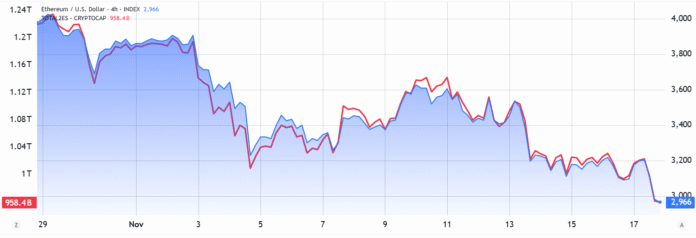Ethereum’s Price Plunge: Understanding the Factors Behind the Drop
The recent decline of Ether (ETH) to a 4-month low below $3,000 has sparked concerns about the potential end of the bull run. Despite the growth of Layer 2 solutions, which have lowered base fees and increased Ethereum’s use in tokenization and stablecoin, the price of ETH has continued to fall. This industry-wide risk aversion has traders worried, with the price correcting by 40% from its all-time high of $4,956 in August.
ETH/USD (blue) vs. altcoin market cap (red). Source: TradingView / Cointelegraph
Ether’s performance closely mirrors the altcoin market, suggesting a lack of asset-specific catalysts and a shift towards broader macroeconomic factors. Analysts argue that the crypto downturn is due to increasing concerns about global growth, including the U.S. government shutdown, new import tariffs, weak earnings in the consumer sector, and doubts about the artificial intelligence industry.
Market Sentiment and Demand for Bullish Leverage
ETH 2-month futures premium on an annual basis. Source: laevitas.ch
Demand for bullish ETH leverage has remained subdued for a month, with the futures premium remaining below the neutral 5% mark. This reluctance is partly due to market stress affecting companies building ETH reserves, including Bitmine Immersion (BMNR US), SharpLink Gaming (SBET US), and The Ether Machine (ETHM US). These companies are showing unrealized losses as their shares trade below net asset value, reducing demand for new debt and leading to gradual dilution of current holders.
Ethereum’s On-Chain Activity and Its Impact on Price
Ethereum TVL (left, blue) vs. DEX volumes (purple), USD. Source: DefiLlama
Ether’s weak on-chain data has also dented investors’ bullish appetite. Lower network activity reduces demand for ETH and increases supply. Ethereum’s burn mechanism only becomes useful when demand for base layer data increases, so slower DApp usage is a net disadvantage for ETH staking. Deposits on the Ethereum network, as measured by total value locked (TVL), fell to a four-month low of $74 billion, down 13% from 30 days earlier.
Blockchains sorted by 30-day DEX volume, USD. Source: DefiLlama
Critics might argue that BNB Chain and Solana are more centralized, and that Ethereum is the leader when considering the Layer 2 ecosystem. Scaling solutions such as Base, Arbitrum, and Polygon have significantly improved Ethereum’s capacity but also raised concerns about fees. Because rollups batch and process transactions outside of the base layer, they significantly reduce the demand for base layer fees.
Republic Raises $100 Million for ETH Purchases
Blockchains ranked by seven-day transactions. Source: Nansen
Still, the shift in activity to Layer 2 systems is by no means a threat. The rise of Ethereum’s scaling ecosystem has strengthened its lead in real-world asset tokenization (RWA) and decentralized stablecoin systems like Sky, formerly known as MakerDAO. Base alone processed nearly 102 million transactions in the last seven days, a number comparable to networks with many more users and deposits like Solana.
Ether’s prospects depend heavily on reduced global socio-political uncertainty, particularly as the US comes under pressure from its rising national debt. Ultimately, central banks will likely need to add liquidity and support their economies, and ETH is well-positioned to benefit from this inflow. Such a shift could be enough for Ether to retest the $3,900 mark. For more information on the current state of Ethereum and its potential future developments, visit Cointelegraph.

